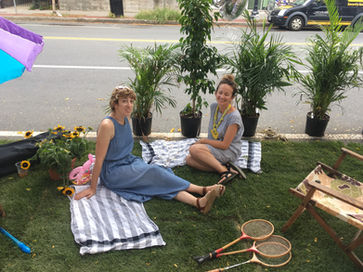
PRACTICE SPACE DESIGN STUDIO
design studio / public space / artist-in-residence / curated programming
2016-2020, Inman Square, Cambridge, Massachusetts

CONTEXT
Inman Square is a historic neighborhood situated between MIT and Harvard University. It is a busy district where people walk to restaurants, nightlife, and cultural activities. Practice Space existed within this neighborhood in the years between the Trump presidency and the pandemic, a historic period of unrest and women-centered empowerment. With Diana Lempel, I founded and co-directed Practice as an experimental storefront, a studio for art, design and research, and a celebration of women’s work. All of our funding came directly from our community. As a business, we were committed to sustainability - financial, emotional, physical, and environmental - and to making space in the economy for our work and values. Practice Space was an important contribution to the neighborhood’s business district, to the women’s movement in Cambridge, and to the continuation of our own curiosities.

RESEARCH QUESTIONS
Each season, Practice Space adopted a new research question. When is color material? How do we make a new economy? What is the idea of North? Even, Why do we dream of California? These questions responded to the seasons, longings, concerns, or curiosities. Around each question, we curated objects in the shop, invited artists, a series of events, and community engagements. A reader board mounted above the Practice Space entryway broadcast messages that related to the questions, asking passersby to practice gratitude or practice empathy or practice small talk with strangers. The questions and messages echoed throughout the neighborhood and generated dialog; they were helpful in bringing people across the threshold and into the space.

SHOP
We considered Practice Space as a rotating installation of objects, ideas, and people. Our storefront was anchored by a shifting collection of merchandise carefully curated around our research questions and lovingly presented for public consumption. With a focus on high quality materials and durability, including work wear for women such as overalls and jumpsuits. Whenever possible, we sourced ethically-made, hand-crafted items such as ceramic bowls and mugs, wool blankets, backpacks, jewelry, and art supplies. We also carried a rotating selection of zines, artist-made books, cookbooks, and letterpress cards that were available for browsing as well as purchase. While the shop was functional as a retail space it was also a space for exhibitions, events, experiments, and community announcements.

CURATED EVENTS & PUBLIC PROGRAMS
Each season, we curated a series of public programs - some free, some by RSVP, some as a ticketed event. The scale of our programs telescoped to accommodate the question being asked or the opportunity being created. We led recurring workshops on how to bind your own journal and meditation through color mixing with acrylic paint. We hosted a natural wine tasting for a woman-owned local business. We held dance parties and readings and lectures, each specially crafted to consider the research question at hand. With a strong affinity for food, we held many dinner parties, one in which each participant cooked a dish from a Julia Childs cookbook.

ARTIST ACTIVATIONS
Each season brought with it a new question and with each new question, the opportunity to invite artists. Throughout the life of Practice Space, artists visited for a week or a day and were supported to do what they wanted to with the resources of the space. Visiting artists sometimes installed their work in the shop, sometimes they designed events or hosted a sing-a-long. Carissa Potter Calson organized a neighborhood choir of “Love and Longing”, Katie Mullins wrote songs and performed on the door threshold, Helen Miller moved her body in somatic practice, Summer Lee and Laura Boles Faw wrote letters live on the sidewalk. Tim Devin led tours of his mapped out utopia. As artists ourselves, it was important to build a community while being transparent about the process and labor of creativity.

COMMUNITY-BASED DESIGN
Practice Space also operated as a design studio that organized and curated community events. We activated our sidewalk in order to participate in global events such as PARK(ing) DAY and neighborhood festivities like Inman Eats. We worked beyond our local block, we were hired to develop activities for youth, curate exhibitions of ephemera from local archives, produce documentary photo projects, and organize a 50th anniversary celebration of a nearby housing project. We worked with our clients to highlight what was important to them while suggesting new ideas such as a community-sourced recipe collection, cooked for the community by local chefs. We infused each assignment with color and consideration so that participants and guests could experience a collective and multisensory wonder. In this way, Practice Space found community on both sides of its threshold.

AFTERMATH
After 3 years, our lease on Practice Space was up. Diana recently had a baby, our beloved employee had left for a wonderful opportunity, and I could no longer afford my nearby apartment. We decided that three years had been a good run and spent the last two months of our lease enjoying a long and meaningful goodbye with our community. Ironically, three months later many neighborhood businesses were suddenly shut down (both temporary and permanent) with the COVID-19 outbreak. I remain passionate about the potential for small businesses to be successful, conceptually meaningful, community-engaged, aesthetically pleasing.
















